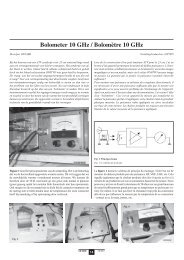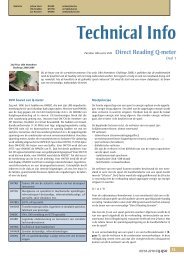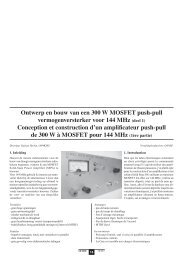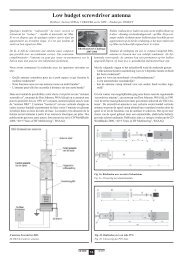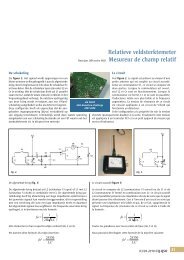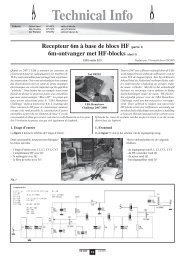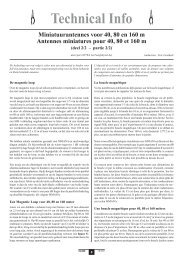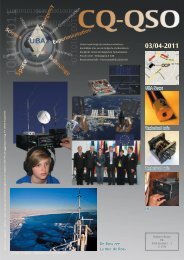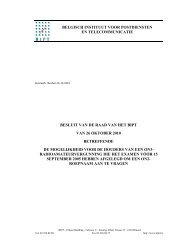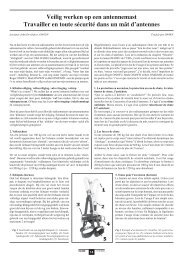IARU Region 1 VHF Managers Handbook - UBA
IARU Region 1 VHF Managers Handbook - UBA
IARU Region 1 VHF Managers Handbook - UBA
Create successful ePaper yourself
Turn your PDF publications into a flip-book with our unique Google optimized e-Paper software.
7.5 DEFINITION FOR PING AND BURST FOR SCIENTIFIC ANALYSIS OF AMATEUR RADIO<br />
METEOR SCATTER<br />
<strong>IARU</strong> <strong>Region</strong> 1 page 106/148 Version 5.40<br />
<strong>VHF</strong> managers handbook<br />
SRAL Finland<br />
For the analysis of scientific data the old way of defining a ping and a burst, which depended on<br />
information / no information, is not relevant.<br />
Therefore for the correct analysis the following definitions should be used:<br />
Ping: Reflection from an underdense meteor trail.<br />
Burst: Reflection from an overdense meteor trail.<br />
Background:<br />
Radio Amateurs have used the term "ping" to describe a Ashort@ reflection. Most of the European<br />
operators define "ping" as a reflection too short to pass information. This definition was most likely<br />
evolved in the 1970's, when high speed CW (then < 600 LPM) gained popularity in Europe. With the<br />
less efficient equipment used those days, the shorter reflections were either too short to pass full<br />
characters due to slow speed and/or too weak to decode with the equipment available at that time.<br />
Some operators define "ping" as a reflection from an underdense meteor trail and "burst" as a<br />
reflection from an overdense trail. This is also how Aping@ and Aburst@ are described in The<br />
<strong>VHF</strong>/UHF DX Book (published by RSGB). Generally it can be said that most good reflections come<br />
from overdense trails and short/less usable reflections (pings) from underdense trails. Overdense and<br />
underdense reflections can be roughly separated by duration of the reflection (reference 1).<br />
The principal difference of underdense and overdense trail is the mechanism that re-emits RF-energy.<br />
On underdense trails the RF-energy penetrates the trail and makes electrons oscillate and re-radiate<br />
energy, while on overdense trails, no penetration occurs and the trail is modeled as a metallic cylinder<br />
reflecting RF-energy. When receiving meteor reflections the audible differences are found in signal<br />
strength, duration and decaying shape.<br />
CW speeds used in MS have increased since 1970's by about four times and new digital equipment<br />
(i.e. DTR) make copying useful information from a weak reflection now much more easier. The old way<br />
of defining a ping has thus become invalid and does have serious lack of logic by definition, while the<br />
underdense/overdense division is based on well known and studied physical facts, as described in<br />
scientific literature.<br />
It would also be extremely useful, if MS working results published i.e. in DUBUS were of scientific use.<br />
Such working results could be used by people like OH5IY, who are doing scientific research on meteor<br />
scatter. QSO information in DUBUS contain the number of pings and bursts of every contact. This<br />
information is of little use, however, if ping is understood as a reflection with no information, thus<br />
depending on speed used. Instead, if ping is defined as an underdense reflection this kind of<br />
information would be of great value. The relative number of underdense and overdense reflections<br />
could be compared between different showers and between consecutive hours in the same shower.<br />
This would provide us new knowledge of meteor showers and sporadic meteors.<br />
Aid for defining underdense and overdense trails:<br />
Underdense and overdense reflections can be roughly separated by duration of the reflection (which<br />
varies by frequency). The threshold is not sharp, but a simple approximation can be made. On 50 MHz<br />
overdense trail durations are typically greater than 0.5 s (reference 1) and maximum underdense trail<br />
durations approximately 0.5-1 s (reference 2).




